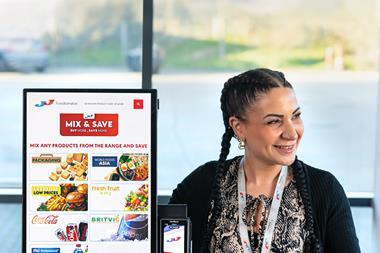How tricky will it be to comply with new EU traceability rules asks Elaine Watson
Tracing a chicken ready meal back to its source should be easy. All you need do is look at the best-before date and work back. The factory that made it makes one batch per day and typically adds 15 days from the production date to generate the best-before date.
Following this logic, count back 15 days and you can work out what batch it came from. Assuming you have stringent batch control, you should also be able to identify precisely which shipment of raw materials delivered to the factory went into that batch. It’s that simple. Forget RFID, lot codes and hi-tech electronic systems. You’ve met the traceability requirements of the new EU General Food Law, which hit UK statute books on January 1.
But what happens if there is no batch code, or the best-before date is wrong, or if the factory happened to use chicken offcuts from a previous batch in the batch you are attempting to trace - and the link between individual batches and specific materials shipments is lost?
Moreover, what if counting back 15 days does not lead you to the batch you actually want because the one you are looking for was made using sauce from vegetables a day older than usual, reducing the production best-before date cycle to 14 days instead of 15?
Indeed, what if multiple batches have the same use-by date because the factory had to make more than the standard single batch that day?
Article 18 of the EU General Food Law 178/2002 makes deceptively simple demands. To ensure complete traceability in the supply chain, food companies must be able to identify where they got their products from and who they sold them to - so-called ‘one-up one-down’ traceability. But in practice, the obligations are far from simple. Take that chicken ready meal. The chicken in it might have been sitting in a wholesaler’s freezer for two years before the ready meal supplier even bought it. From here, it was probably transferred to the supplier’s own freezers for months before being made into a ready meal, and, once processed, was stored in a consolidation centre for several more weeks before it even made it to supermarkets. That’s perhaps three to four years of records you need to be able to produce to the authorities on demand (generally within hours), as the law requires.
Moreover, what if the data that underpins your traceability systems is wrong in the first place, says James Butcher at package coding management software supplier Claricom. “Take a barcode. Most suppliers manually enter barcode numbers into a machine that generates them and prints them off, and, occasionally, the wrong number is inputted. The same applies to the sell-by date, and other data on food packaging. If you are relying on this data for traceability, you could be in trouble, which is why suppliers are increasingly looking to companies such as Claricom to centrally manage the information that goes into coding machines and label printers, and stop these errors.”
Indeed, two recent high-profile product recalls just before Christmas - a Sainsbury’s Chicken Al Forno chilled ready meal and a whole group of chilled meals for Waitrose - were initiated because the products in question were incorrectly date-coded, he adds. “There are withdrawals every single day, usually because of stupid errors. There is an elephant in the room and no one wants to admit that it’s there.”
A recent DTI-commissioned study also revealed significant black holes in UK food suppliers’ paper trails, particularly where companies were importing ingredients from overseas.
Study team leader Vincent Tombros from business assurance consultant Lysis says: “We were surprised by how insufficient business assurance controls were, as implemented by companies using overseas suppliers. Many companies risk falling foul of the regulations.”
However, fear of falling foul of Article 18 should not be the only motivating factor in upping your game, says Neil Griffiths, chairman at legal advisor to the food industry Law Laboratories.
Purely treating this as a legal issue is missing the point, he adds. After all, poison your customers and the least you will have to worry about is the FSA on your back or the cost of the recall. How much more will it cost to rebuild a shattered reputation or win back market share? “I have heard many complain about the costs of establishing systems,” he adds, “but very little about the costs of not having them.”
As Article 18 doesn’t prescribe how companies should go about establishing traceability, everyone has a slightly different system, says Geest procurement development manager David Barney. “There is no common system in place. At Geest, we can pin things down to production lines and exact times, and from that we can establish exactly which raw materials went into that product. For suppliers like us, legislation is the least of our worries. What’s driving traceability are retailer requirements and the need for food safety, plant efficiency and food assurance.”
Start cold-calling suppliers, and it becomes pretty clear that several sizeable companies are blissfully unaware of what is coming out of the EU on the traceability front.
One contribution to an industry chatroom in November 2004, is fairly typical: “I have just returned from a trip to a small island country in the Indian Ocean exporting tuna to the EU. I met government, industry and fishing companies. Approximately 90% of the people I spoke with had no idea about Article 18.”
If UK suppliers are generally better equipped on the traceability front, there is little room for complacency, says Griffiths.
“Although many suggest the law only requires one-step-back, one-step-forward traceability, in my view this is a too limited interpretation. Reworking and other areas such as bulking or mixing can lead to physical traceability being lost. A manufacturer needs to assess the risks and this may lead to changes in procedures or an acceptance that, should a problem occur, a bigger product recall than otherwise necessary might be needed.
“Purely concentrating on one statute and ignoring others such as HACCP and due diligence is risky.”
Ironically, now that the FSA has clarified how Article 18 will be interpreted in the UK, many in the industry argue that the final version of the legislation is in any case so watered down that it will merely set a baseline rather than a gold standard for traceability.
Although the first part of Article 18 says traceability should be established across all stages of the chain, the FSA says you have only committed an offence if you cannot name who supplied you with your ingredients and who you sold them on to, says Griffiths. Internal tracking in the factory and good batch control, essential for traceability, is not actually a legal requirement.
“If you were in the dock on food poisoning charges and due diligence was your defence, you’d be laughed out of court if you said you couldn’t actually track what materials had gone into products,” he says. “Come January 2006, you have to implement stringent HACCP under new hygiene laws anyway.”
Tracing a chicken ready meal back to its source should be easy. All you need do is look at the best-before date and work back. The factory that made it makes one batch per day and typically adds 15 days from the production date to generate the best-before date.
Following this logic, count back 15 days and you can work out what batch it came from. Assuming you have stringent batch control, you should also be able to identify precisely which shipment of raw materials delivered to the factory went into that batch. It’s that simple. Forget RFID, lot codes and hi-tech electronic systems. You’ve met the traceability requirements of the new EU General Food Law, which hit UK statute books on January 1.
But what happens if there is no batch code, or the best-before date is wrong, or if the factory happened to use chicken offcuts from a previous batch in the batch you are attempting to trace - and the link between individual batches and specific materials shipments is lost?
Moreover, what if counting back 15 days does not lead you to the batch you actually want because the one you are looking for was made using sauce from vegetables a day older than usual, reducing the production best-before date cycle to 14 days instead of 15?
Indeed, what if multiple batches have the same use-by date because the factory had to make more than the standard single batch that day?
Article 18 of the EU General Food Law 178/2002 makes deceptively simple demands. To ensure complete traceability in the supply chain, food companies must be able to identify where they got their products from and who they sold them to - so-called ‘one-up one-down’ traceability. But in practice, the obligations are far from simple. Take that chicken ready meal. The chicken in it might have been sitting in a wholesaler’s freezer for two years before the ready meal supplier even bought it. From here, it was probably transferred to the supplier’s own freezers for months before being made into a ready meal, and, once processed, was stored in a consolidation centre for several more weeks before it even made it to supermarkets. That’s perhaps three to four years of records you need to be able to produce to the authorities on demand (generally within hours), as the law requires.
Moreover, what if the data that underpins your traceability systems is wrong in the first place, says James Butcher at package coding management software supplier Claricom. “Take a barcode. Most suppliers manually enter barcode numbers into a machine that generates them and prints them off, and, occasionally, the wrong number is inputted. The same applies to the sell-by date, and other data on food packaging. If you are relying on this data for traceability, you could be in trouble, which is why suppliers are increasingly looking to companies such as Claricom to centrally manage the information that goes into coding machines and label printers, and stop these errors.”
Indeed, two recent high-profile product recalls just before Christmas - a Sainsbury’s Chicken Al Forno chilled ready meal and a whole group of chilled meals for Waitrose - were initiated because the products in question were incorrectly date-coded, he adds. “There are withdrawals every single day, usually because of stupid errors. There is an elephant in the room and no one wants to admit that it’s there.”
A recent DTI-commissioned study also revealed significant black holes in UK food suppliers’ paper trails, particularly where companies were importing ingredients from overseas.
Study team leader Vincent Tombros from business assurance consultant Lysis says: “We were surprised by how insufficient business assurance controls were, as implemented by companies using overseas suppliers. Many companies risk falling foul of the regulations.”
However, fear of falling foul of Article 18 should not be the only motivating factor in upping your game, says Neil Griffiths, chairman at legal advisor to the food industry Law Laboratories.
Purely treating this as a legal issue is missing the point, he adds. After all, poison your customers and the least you will have to worry about is the FSA on your back or the cost of the recall. How much more will it cost to rebuild a shattered reputation or win back market share? “I have heard many complain about the costs of establishing systems,” he adds, “but very little about the costs of not having them.”
As Article 18 doesn’t prescribe how companies should go about establishing traceability, everyone has a slightly different system, says Geest procurement development manager David Barney. “There is no common system in place. At Geest, we can pin things down to production lines and exact times, and from that we can establish exactly which raw materials went into that product. For suppliers like us, legislation is the least of our worries. What’s driving traceability are retailer requirements and the need for food safety, plant efficiency and food assurance.”
Start cold-calling suppliers, and it becomes pretty clear that several sizeable companies are blissfully unaware of what is coming out of the EU on the traceability front.
One contribution to an industry chatroom in November 2004, is fairly typical: “I have just returned from a trip to a small island country in the Indian Ocean exporting tuna to the EU. I met government, industry and fishing companies. Approximately 90% of the people I spoke with had no idea about Article 18.”
If UK suppliers are generally better equipped on the traceability front, there is little room for complacency, says Griffiths.
“Although many suggest the law only requires one-step-back, one-step-forward traceability, in my view this is a too limited interpretation. Reworking and other areas such as bulking or mixing can lead to physical traceability being lost. A manufacturer needs to assess the risks and this may lead to changes in procedures or an acceptance that, should a problem occur, a bigger product recall than otherwise necessary might be needed.
“Purely concentrating on one statute and ignoring others such as HACCP and due diligence is risky.”
Ironically, now that the FSA has clarified how Article 18 will be interpreted in the UK, many in the industry argue that the final version of the legislation is in any case so watered down that it will merely set a baseline rather than a gold standard for traceability.
Although the first part of Article 18 says traceability should be established across all stages of the chain, the FSA says you have only committed an offence if you cannot name who supplied you with your ingredients and who you sold them on to, says Griffiths. Internal tracking in the factory and good batch control, essential for traceability, is not actually a legal requirement.
“If you were in the dock on food poisoning charges and due diligence was your defence, you’d be laughed out of court if you said you couldn’t actually track what materials had gone into products,” he says. “Come January 2006, you have to implement stringent HACCP under new hygiene laws anyway.”



















No comments yet